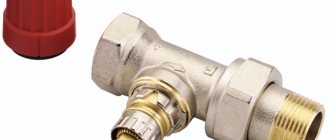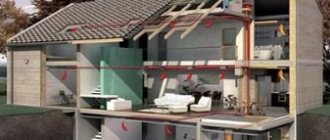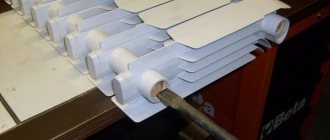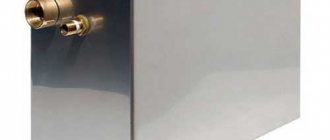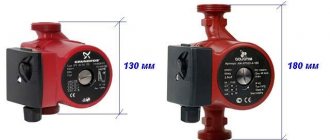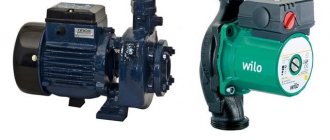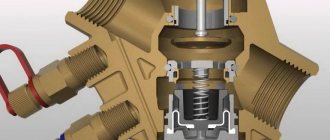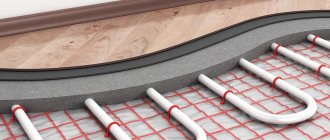In modern heating systems of private houses or apartments, shut-off and control valves are almost always installed on the connections to radiators. Previously, batteries were usually connected directly to risers and this fact did not upset anyone. However, since then, priorities have changed, and every homeowner has become imbued with the need to save energy. Why install taps for heating radiators, how installing fittings relates to savings and which products are best to choose for this purpose will be discussed in our material.
Ball valve
This is the most famous type of shut-off valve. Inside it there is a smooth ball that has a through hole and is capable of rotating 90°C, thus regulating the flow of water in the pipe, closing or opening it. The design of the mechanism provides it with minimal resistance to flow when open. It is designed to operate in the fully open or fully closed position to quickly shut off the water or, in some cases, drain it. Intermediate provisions are possible, but prohibited.
The materials for these mechanisms will be nickel-plated brass and stainless steel; for metal-plastic systems, polymer materials are also used. There are expensive and high-quality cranes from the Danfoss, Giacomini, and Bugatti brands on the market. For limited financial capabilities, Chinese and Turkish Valtec and Fado are offered. Good quality at a low price is offered by the Chinese AGUA-WORID.
The most common type of tap is a valve. Allows you to regulate the pressure. The flow channel inside it is perpendicular to the flow of liquid in the supply pipes. Installation must be carried out with careful attention to the markings so that water flows only in one direction.
For heating systems there are valves with a conical valve. They are most effective for such conditions. Fully open, it allows the maximum amount of liquid to pass through, which makes the thermal output of the battery more efficient. The mechanism allows you to reduce the flow of coolant and reduce heat transfer if the room is too hot and, thus, control the temperature.
There are these types:
- adjusting (straight and angular). They have manual control. Used in autonomous heating. They cannot accurately adjust heat transfer due to the lack of a scale and temperature sensor;
- equipped with a thermal head. Their design allows the temperature rise to be blocked or limited through manual or automatic control. Installed on two- and one-pipe systems. Adjustment is simple - the required temperature is set manually using a limit ring;
- with thermostat. Installed in front of the battery. The flow of coolant is controlled by a tap mounted in front of the thermostat.
There are no valve taps made of plastic; they are made from brass, steel or a combination of these materials.
Heating radiator maintenance
Elementary ball valves installed on the supply and return pipelines will help eliminate a leak or replace a heating device without draining the coolant from the system. The operating position of the device is open or closed, the flow of hot water in the open position is maximum, in the closed position there is no flow.
Manual control of coolant flow
A cone valve helps to smoothly regulate the amount of liquid in the radiator. The cone-shaped stem in its design gives the user the opportunity to approximately adjust a comfortable microclimate. In extreme positions, the valve completely shuts off or opens the flow of water.
Removing air from the system
An air lock that forms in the upper part of the radiators when starting water does not allow full use of the working surface of the heating device.
A specialized Mayevsky faucet helps remove this air.
In operating condition, its valve is always closed; it opens only when setting up the system.
Automatic flow control
Precise adjustment of the microclimate makes it possible to perform a control valve with a thermostatic head. The liquid or gas bellows in its composition reacts to changes in ambient temperature and automatically controls the coolant flow.
Selection and installation of radiator taps
Connecting heating devices using properly selected shut-off and control valves improves the functionality of the heating system and makes operation more convenient. The tap for the heating radiator must be made of high-quality materials and installed correctly.
Fittings for heating radiators are divided into shut-off (blocks the coolant flow) and regulating (designed to control the flow intensity). Taps are only shut-off valves; regulating valves are valves and valves. But in everyday life, taps mean all types of shut-off and control valves.
Conclusion
Having figured out which valves are best for heating radiators to use, you can choose shut-off and control valves with optimal parameters for an autonomous system in your home. The choice is influenced by specific conditions of use, system requirements, and financial capabilities.
If regulation of heating devices is not required, it is enough to install shut-off valves. Balancing a system with a constant coolant temperature requires the installation of appropriate valves or simple mechanical valves to regulate the flow in different parts of the circuit. If you want to provide an individual temperature regime for each room, you cannot do without thermostatic valves - semi-automatic or automatic. Investments in appropriate control valves will pay off in the future due to energy savings.
Video on the topic:
Ball valve
This is the most famous type of shut-off valve. Inside it there is a smooth ball that has a through hole and is capable of rotating 90°C, thus regulating the flow of water in the pipe, closing or opening it. The design of the mechanism provides it with minimal resistance to flow when open. It is designed to operate in the fully open or fully closed position to quickly shut off the water or, in some cases, drain it. Intermediate provisions are possible, but prohibited.
The materials for these mechanisms will be nickel-plated brass and stainless steel; for metal-plastic systems, polymer materials are also used. There are expensive and high-quality cranes from the Danfoss, Giacomini, and Bugatti brands on the market. For limited financial capabilities, Chinese and Turkish Valtec and Fado are offered. Good quality at a low price is offered by the Chinese AGUA-WORID.
The most common type of tap is a valve. Allows you to regulate the pressure. The flow channel inside it is perpendicular to the flow of liquid in the supply pipes. Installation must be carried out with careful attention to the markings so that water flows only in one direction.
For heating systems there are valves with a conical valve. They are most effective for such conditions. Fully open, it allows the maximum amount of liquid to pass through, which makes the thermal output of the battery more efficient. The mechanism allows you to reduce the flow of coolant and reduce heat transfer if the room is too hot and, thus, control the temperature.
There are these types:
- adjusting (straight and angular). They have manual control. Used in autonomous heating. They cannot accurately adjust heat transfer due to the lack of a scale and temperature sensor;
- equipped with a thermal head. Their design allows the temperature rise to be blocked or limited through manual or automatic control. Installed on two- and one-pipe systems. Adjustment is simple - the required temperature is set manually using a limit ring;
- with thermostat. Installed in front of the battery. The flow of coolant is controlled by a tap mounted in front of the thermostat.
There are no valve taps made of plastic; they are made from brass, steel or a combination of these materials.
Design and operating principle
The principle of operation of balancing valves is to block the flow of liquid with a retractable valve or rod, causing a reduction in the cross-section of the passage channel. The devices have different designs and connection technologies; in a heating system they can additionally:
- Maintain the pressure drop at the same level.
- Limit coolant consumption.
- Shut off the pipeline.
- Perform drain functions for working fluid.
Structurally, balancing valves resemble conventional valves; their main elements are:
- Brass body with two through pipes with internal or external threads designed to connect to a line with standard pipe diameters. The connection in the pipeline, in the absence of a threaded fitting with a movable threaded nut (American), is made through its analogues - additional adapter couplings with different union nuts.
- A locking mechanism, the movement of which regulates the degree of blocking of the coolant passage channel.
Rice. 4 Danfoss LENO MSV-B manual balancing valve
- Adjustment handle with scale and setting indicators, allowing you to adjust the flow inside the device.
- Modern models are equipped with additional elements in the form of two measuring fittings, with the help of which the flow volumes (throughput) are measured at the inlet and outlet of the device.
- Some models are equipped with a shut-off ball mechanism that allows you to completely shut off the flow, or have the function of draining liquid from the water supply.
- High-tech modern types can be controlled automatically; for this, instead of a rotating head, a servo drive is installed, which, when power is supplied, pushes the locking mechanism, and the degree of channel closure depends on the amount of voltage applied.
Rice. 5 Danfos AB-QM automatic balancers - design
Types of heating systems and the principle of adjusting radiators
Handle with valve
In order to correctly adjust the temperature of radiators, you need to know the general structure of the heating system and the layout of the coolant pipes.
In the case of individual heating, adjustment is easier when:
- The system is powered by a powerful boiler.
- Each battery is equipped with a three-way valve.
- Forced pumping of coolant has been installed.
At the stage of installation of individual heating, it is necessary to take into account the minimum number of bends in the system. This is necessary in order to reduce heat loss and not reduce the pressure of the coolant supplied to the radiators.
For uniform heating and rational use of heat, a valve is mounted on each battery. With it, you can reduce the water supply or disconnect it from the general heating system in an unused room.
- In the central heating system of multi-storey buildings, equipped with a vertical supply of coolant through a pipeline from top to bottom, it is impossible to adjust the radiators. In this situation, the upper floors open the windows due to the heat, and the rooms on the lower floors are cold, since the radiators there are barely warm.
- A more advanced one-pipe network. Here, the coolant is supplied to each battery and then returned to the central riser. Therefore, there is no noticeable temperature difference in the apartments on the upper and lower floors of these buildings. In this case, the supply pipe of each radiator is equipped with a control valve.
- A two-pipe system, where two risers are mounted, ensures the supply of coolant to the heating radiator and back. To increase or decrease the coolant flow, each battery is equipped with a separate valve with a manual or automatic thermostat.
What taps are best to install on radiators?
In modern heating systems of private houses or apartments, shut-off and control valves are almost always installed at connections to radiators. Previously, in most cases, batteries were connected directly to risers, and this did not upset anyone.
However, since then, priorities have changed, every homeowner has realized the need to save energy.
Why install taps on heating radiators, how installation of fittings relates to savings and which products are best to choose for this, we will tell you in our material.
Why do we need battery-powered faucets?
For a general understanding, let's clarify the terminology a little. In common parlance, faucets are any plumbing fixtures that have a handle for manually controlling the flow of water.
In fact, calling the valve a shut-off valve rather than a control valve is technically correct.
In other words, it is designed solely to close the direction of fluid, and there are other devices to regulate the amount of fluid - valves and valves. In addition, all these products are used for batteries.
Shut-off and control valves are installed on the supply pipelines of space heating devices:
- turn off the battery during the year when it is not very cold outside or for other reasons;
- turn off the water to check and rinse the device without emptying the entire network of pipes;
- manual or automatic regulation of coolant flow, quantity adjustment depending on the ambient temperature.
The first point of the checklist perfectly illustrates how installing battery-powered faucets is related to energy saving. Often in the warm season the central heating is turned on.
It’s still very hot outside, but the radiators are already working, and it’s stuffy in the house. If there is a tap, the problem can be solved by turning the handle.
And when installing a heat energy meter in the entrance or throughout the house, with the same movement, the flow of funds from the family budget to the account of the heat supply organization is interrupted.
The same thing happens in a private house equipped with an individual heat source. Taps allow you to turn off some radiators in residential or temporarily used technical rooms, for example, in a garage.
Advice
This is very important for saving money and periodically cleaning indoor heating devices.
After all, what happens: a dirty battery inside emits less heat into the room, which means that the coolant with a higher temperature leaves the return pipe.
This coolant will heat your neighbors’ house, and you will feel a lack of heat in your apartment. In a private house, water returns to the boiler and there are no leaks.
However, the rooms are colder and to obtain the required amount of heat it will be necessary to increase the temperature of the heating system by increasing the fuel consumption of the heat generator.
The pollution process is insidious because it takes time and only becomes noticeable when the cost of heating the building increases.
The use of manual or automatic control valves with thermal heads allows you to save energy sources during the heating season by maintaining the required ambient temperature in the premises.
Manual radiator valves allow you to regulate the coolant flow when setting up the system so that it does not exceed the calculated one.
Valves with thermal heads automatically regulate the flow of liquid, reducing or increasing the flow area depending on the ambient temperature in the room.
Types of taps for space heating devices
At the moment, there are the following types of radiator taps:
- spherical straight and angular full bore made of brass;
- full passage of polypropylene ball;
- control valves;
- thermostats with manual and automatic control with thermal head.
The most popular type of shut-off devices are hinged valves made of brass or polypropylene. The main element in them is a steel sphere with a sample of the appropriate diameter for the passage of water.
it is attached to a rod, the rotation of which is blocked by the coolant. When the valve is open, the sample in the sphere is connected to the internal passage of the product; in the closed position, it rotates 90 degrees relative to it?.
This does not change the direction of flow.
For reference. Some well-known manufacturers recommend shut-off valves that have a built-in drain valve for draining a radiator or section of piping.
The manual valve on the accumulator is a design in which the fluid changes direction twice, passing through the working part of the seat.
Note
To reduce the amount of coolant passing through, this section is partially blocked by a cone or washer with a rubber gasket (in old valves) attached to the stem.
The automatic radiator valve has a similar design, only the rod with the cone does not rotate along the thread, it is simply pressed. Pressing is carried out by a thermal head or a plastic handle for manual control.
All listed devices are available in a corner version. This corner radiator mixer allows you to easily connect your space heating unit from the side to pipes running above or below the floor. The meaning of its operation is similar to direct products.
Types of materials used
When deciding which faucet to install on the heating radiator, you should pay attention to the material it is made of. First of all, the main requirement for the material is its anti-corrosion properties.
Most often, synthetic brass is used for production, and products made from high-quality polypropylene are also popular. The top layer can be additionally protected by metal spraying.
Depending on the material, the types of fastenings differ. Thus, a brass faucet is attached using a fitting or thread to pipes made of plastic or metal. To install a polypropylene valve, you will need to select a welding method.
Balancing valve
The design of a valve for regulating heating differs from a conventional ball valve in that it can smoothly close the flow area in a few turns. Moreover, after balancing, the position of the valve can be fixed so that no one accidentally violates the settings. This type of control valves is installed at the outlet of the radiator, as shown in the diagram:
Shown here is the connection to a two-pipe horizontal system, most common in private houses and apartments with individual heating. By the way, the principle of installing fittings with a single-pipe scheme remains the same. A regular ball valve is installed on the supply line, and an adjustment valve is installed on the return line. In the case when a two-story house has a system with vertical risers, the installation diagram of the accompanying fittings looks like this:
The principle of product selection is the same as in the previous section
Straight or angular design is accepted depending on the layout of equipment and pipelines; it is also important to use American designs during assembly
Pay special attention to the quality of casting and the thickness of the brass walls of the fittings. If you have networks made of polypropylene pipes, do not rush to buy PPR taps; it is better to install adapters and reliable metal products. Advice
Balancing valves are installed on all radiators, except for the very last one, located at the dead end of the branch. It is enough to install simple ball valves on the connections to it
Advice. Balancing valves are installed on all radiators, except for the very last one, located at the dead end of the branch. It is enough to install simple ball valves on the connections to it.
Useful information for those who want to choose a universal locking device
Valve on the battery
Choosing a tap for a radiator
It is important to pay attention to the material from which it is made. The locking device operates in the most aggressive environment. It is constantly in water, exposed to high temperatures and hydraulic shocks.
Therefore, it is important that the material can withstand all these negative factors
It is constantly in water, exposed to high temperatures and hydraulic shocks.
Therefore, it is important that the material can withstand all these negative factors
Most often, radiator taps are made of alloys. Most models are made of brass. This is a very durable metal that is not afraid of corrosion. But for even greater strength, the brass is coated on top with a protective metallic compound. This is the best option for use in a heating system.
Sometimes, instead of brass taps, sellers can slip in counterfeits - silumin control valves, which look exactly like the original models.
After a year of operation, breakdowns often occur that can lead to utility accidents. After all, silumin rusts very quickly from the inside, and corrosion instantly corrodes the body, making its walls very thin. Therefore, any water hammer easily breaks the locking device. Even if this does not happen, there are often cases when, when simply opening or closing a tap, it simply remains in the hands of a person, falling off from the base. If there is hot water inside the battery at this time, burns will definitely occur. So beware of fakes!
So, the tap for the heating battery must be made of brass - only this alloy can easily withstand high temperatures and water shocks. It is better to choose ball locking mechanisms that have long warranty periods and demonstrate increased tightness. This crane can be installed in both horizontal and vertical positions.
Harness
Modern heating systems are equipped with the following battery connection diagram:
- The supply pipe and the battery are separated by a control valve. We are talking about a manual valve or a valve with a thermostat.
- The return pipe and radiator are separated by a ball valve.
- The inlet and outlet shut-off pipes are additionally equipped with a bypass (jumper). Thanks to it, the coolant in the right situations has the ability to bypass the battery. Jumpers are used in serial radiator connection diagrams.
To make the operation of heating radiators more efficient, they are equipped with different types of shut-off valves, depending on the technological requirements of the system. It is for this reason that different types of taps and valves are installed on the supply and return pipes.
To be able to independently regulate the operation of heating radiators, individual meters and taps are installed in the apartment. The radiator valve must be selected taking into account all the features of the heating system of a residential building. You can install the device yourself.
Valves in a residential heating system
Functional purpose
Why complete the radiator with taps? Their installation when connecting heating devices makes it possible
:
- completely turn off the radiators if for some reason the room is temporarily not required to be heated;
- shut off the coolant supply to flush or inspect individual radiators without draining the coolant from the entire system;
- regulate the intensity of heat transfer from batteries manually or automatically, maintaining a comfortable temperature in the room;
- remove air pockets from radiators, increasing system efficiency and reducing the risk of corrosion of metal elements.
Application
Valves on radiators are needed mainly to shut off the liquid inside them. They act as a locking system.
This gives them the following functionality:
- If necessary, turn off the heating system;
- Shutting off the fluid in the system to carry out repair and maintenance work on the heating system;
- Adjusting the air temperature according to the preferences of the owner of the room.
Such cases often occur in apartment buildings when it is hot outside and the heating is not turned off or gas meters are installed throughout the house. So this is the result of the colloquial expression <>.
The solution to this problem will also be a tap on the radiator, which will help create not only a comfortable temperature in the room, but also save money.
Specifics of various cranes
There are two types of taps on the market: from automatic to equipment with thermal heads. Each of them has its own specific work.
The manual adjustment taps or automatic valves of the device are equipped with thermal heads, which allows you to save energy during the heating season. This is achieved due to constant indoor air temperature.
In addition, manual taps are designed in such a way that before the start of the heating season, the coolant can be adjusted according to a system that will not allow the coolant to exceed the set speed.
As for valves equipped with thermal heads, where the fluid flow is automatically regulated. Due to this, the flow area in the heating system decreases or increases, which directly depends on the temperature in the room.
Types of control valves
Existing modern heat supply technologies make it possible to install a special tap on each radiator that controls the quality of heat. This control valve is a shut-off valve heat exchanger, which is connected via pipes to the heating radiator.
According to the principle of their operation, these cranes are:
Ball ones, which primarily serve as 100% protection against emergency situations. These shut-off devices are a structure that can be rotated 90 degrees and can allow water to pass through or prevent the passage of coolant.
The ball valve must not be left in a half-open state, as in this case the sealing ring may be damaged and a leak may occur.
- Standard, where there is no temperature scale. They are represented by traditional budget valves. They do not provide absolute accuracy of adjustment. By partially blocking the access of coolant to the radiator, they change the temperature in the apartment to an indefinite value.
- With a thermal head that allows you to adjust and control the parameters of the heating system. Such thermostats are automatic and mechanical.
Conventional direct-acting thermostat
A direct-acting thermostat is a simple device for controlling the temperature in a heating radiator, which is installed near it. By its design, it is a sealed cylinder into which a siphon is inserted with a special liquid or gas that clearly reacts to changes in the temperature of the coolant.
As it increases, the liquid or gas expands. This leads to increased pressure on the rod in the thermostat valve. It, in turn, moving, blocks the flow of coolant. When the radiator cools, the reverse process occurs.
Thermostat with electronic sensor
This device is no different in operating principle from the previous version, the only difference is in the settings. If in a conventional thermostat they are performed manually, then an electronic sensor does not need this.
Here the temperature is set in advance, and the sensor monitors its maintenance within the specified limits. The electronic thermostatic sensor regulates the control parameters of the air temperature within the range from 6 to 26 degrees.
Choosing the right model
Which faucet to choose for a private home largely depends on the type of heating system and the required functionality. It may operate automatically or may require manual adjustment.
The possibility of changing the temperature in the room depends on the operating principle of the taps, which can be divided into conical and valve.
Many people are interested in which valves for heating radiators are best to choose. First you need to pay attention to the quality of the materials. Steel and fittings must be of high quality. The durability of the structure will depend on this.
Valves can be divided into several other types:
- Conical. The simplest type of structure. When the rod is moved manually, the cross section also changes. The downside is that the gasket wears out quickly.
- Semi-automatic designs with thermostat. The temperature will be changed by an automatic sensor. Monitor the quality of the coolant and adjust the cross-section accordingly. The required temperature value is set manually.
- Full automation. Here the sensor already determines the air temperature in the room, transmits the readings to the control unit, which in turn regulates the cross-section of the rods in the batteries. But there are also fully automatic models that can respond not to air temperature, but to the heating level of the coolant.
When choosing heating system elements, you should pay attention to the pipe flow. It should be taken into account that bends reduce it, so pipes must be selected with a large diameter. You can also install a larger capacity mixer. This may also solve the problem.
Risers and valve that cuts off heating areas
The recommendations of specialists in this case do not differ in the originality of the solution, since plug valves are considered the best choice. It is necessary to create conditions in the risers for discharging the coolant liquid and plugs are chosen for this purpose, but they are not always convenient, since it will be quite problematic to unscrew the plug on the supply riser, through which a water flow with a water temperature of about 90 degrees circulates.
As a result, the conclusion is obvious: valves should be installed to discharge the water.
In this situation, you can use screw devices, since they will not have significant disadvantages:
- if the oil seal is installed correctly, it will not have contact with the water flow under pressure;
- water hammers become impossible, since the valve is mostly closed;
- To replace the gaskets, you do not need to reset the entire house system - it will be enough to stop the riser.
Advantages and disadvantages
This type of fittings has its pros and cons.
The advantages of a radiator shut-off, as well as a shut-off and control device include:
- cutting off the flow into this battery, which allows it to be dismantled, repaired and reinstalled without draining the contents from the pipeline;
- turning off the radiator and directing the coolant flow around it through the bypass, which makes it possible to remove the battery without stopping the operation of the entire heating system in the house;
- draining water from a specific heater, bleeding air from it;
- adjusting the amount of heat supplied to the heater.
Elevator unit
In apartment buildings at the entrance and exit from the elevator unit of the heating system. As a rule, valves are installed. Their body has two rings made of corrosion-resistant steel, which encircle the passage for the coolant (mirrors). Another pair of mirrors is located on the surface of the valve - its moving part.
When the damper is in the lower position and lowers, it blocks the movement of water, but if it moves to the upper position, it goes beyond the circulating flow. To close the valve, the consumer needs to rotate the handwheel, which drives the screw-threaded rod. A seal packed around the stem will help ensure tightness. For heating and hot water, the product must be graphite. There is no alternative to this device for pipe diameters of 50 millimeters or more. It is necessary to determine which taps are best for heating radiators.
If this parameter is lower, it is recommended to use modern plug valves, such as in the photo, since valves have serious disadvantages:
- it is necessary to periodically fill the oil seal, even when the valve is not in use, since the packing, in contact with water, is gradually destroyed;
- After a short period of time, the cheeks begin to become overgrown with deposits. If the valve sits for several years without being used, it will not be possible to close it completely;
- In the event of an emergency, every second can be decisive. If it takes literally a moment to close the plug valve, then it will take a long time to rotate the valve’s steering wheel, even when it is fully operational.
It should be noted that plug valves, which are a ball with a channel for water surrounded by a plastic shell, differ in:
- practicality;
- durability;
- reliable fluid retention;
- no need for maintenance.
Plumbing specialists do not recommend purchasing and installing a screw valve on a heating radiator or the same products of any other type.
They have significant design disadvantages:
- The seal will need to be filled periodically if there is no desire to put up with constant leakage along the rod. When it is difficult to replace the valve or fill the oil seal, then to eliminate the leak, the valve must be opened all the way with a little force. The leak will stop due to the fact that the thread on the rod will press the oil seal:
- Rubber gaskets for elements of heating structures have a limited shelf life. Heating radiator valves with flat brass valves do not hold water after a certain time due to the appearance of deposits on the valve and seat. The same locking elements with wedge-shaped valves made of brass, after closing them with force, often jam in the seat;
- All screw valves are installed only along the flow of water. For orientation, there is an arrow on the body of many products. Installing a valve against water inflow will certainly end with the valve tearing off and then shutting off the water tightly.
Another undesirable prospect is associated with the operation of the valve - the possibility of water hammer if the valve is not completely closed and turbulence occurs in the water flow, periodically blocking the seat. Water hammer
- These are short-term pressure surges, as a result of which the weakest parts of the heating circuit are destroyed.
Criterias of choice
A radiator tap is usually a ball-shaped device that regulates the flow of water and connects the pipes to the radiator. Installed on the bypass, riser, at the top of the battery, in places where air accumulates to release it.
It’s not difficult to choose a suitable faucet; you just need to know a few nuances:
- the diameter of the pipes to which it will be connected (DN, in millimeters or inches);
- working pressure (PN, in the range of 15-40 and above);
- connection type, presence of internal or external wire, American.
When choosing, you should take into account the purpose of the reinforcement, its location and the properties of the environment. Also important is the relationship between the inlet and outlet of the valve in the radiator, their relative position.
When choosing, it is necessary to take into account the characteristics of the cranes:
- Ball valves, although the most common and inexpensive, are ineffective. It has only two modes: closing / opening;
- a cone valve is a more acceptable option due to the possibility of an intermediate position. Disadvantage: the valve must be returned to its original position and constantly monitored;
- An automatic thermostat is the most efficient, reliable, but also much more expensive than others. When installed in a single-pipe system, a bypass is required.
Useful tips for choosing
Several features are described below in order to decide which products are best to use.
Locking mechanism
Thermostats have two types of locking mechanisms: a valve and a valve with a cone (rod). The latter is preferred, it allows for smooth adjustment. The temperature is set manually using a mechanical limiting ring. There are also electronic mechanisms, they are more autonomous.
It is better to install ball valves than gate valves, which have a number of disadvantages: the seal wears out faster, becomes overgrown with deposits, and takes a long time to close. Disadvantages of the Mayevsky crane: low maneuverability, it requires a special key or screwdriver, which is inconvenient to use. If its rod is accidentally unscrewed, it is very difficult to screw it back, overcoming the water pressure. Instead, it is recommended to install a regular valve or special automatic radiator air vents. The optimal and affordable option if temperature control is required is a faucet with a thermal head.
Housing and connections
It is better to install not standard ball valves on batteries, but full bore ones. In residential buildings and apartments, such mechanisms with a coupling connection are used.
It is better to choose taps for heating radiators with a steel or bronze body, but most often they use brass ones, since they are cheaper. An imitation of brass is silumin. You should not buy a product made from it; it is a very soft metal. Polymer ones are no less reliable, but they have large dimensions. To replace them, you need to cut out a piece of pipe.
Products with polymer rather than rubber gaskets are more durable. The taps for adjusting the coolant on heating radiators make it impossible to change them without draining the water; this can be done with straight-through taps or with an American valve installed (towards the battery).
Products from Itap (Italy) and Danfoss are considered to be of the highest quality. Approximate price range 700–2000 rub. In the middle price range there are Oventrop brand products - 550–950 rubles. For a limited budget, Luxor is suitable - 450–800 rubles. Chinese or Turkish brands.
Purpose. Characteristic
Taps ensure efficient operation of water pipes. The heating system cannot operate without these devices, and in some situations, using it without them becomes downright dangerous.
When the riser leaks, it is the shut-off valves that shut off the water, which makes it possible to make repairs without stopping the entire system
An important function will also be managing the heat dissipation of the battery.
The minimum set for the normal functioning of a conventional heating system consists of several types of shut-off and control valves. When connecting to the radiator, shut-off ball valves are mounted on the supply pipes, on the outlet and on the bypass. A mechanism is installed on the supply to adjust the coolant pressure. The radiator itself must be equipped with a Mayevsky tap. to bleed air. As you can see, the number of such products is significant and this is by no means an excessive option.
Taken together, this system allows:
- turn off the radiator without shutting off the entire circuit for repair, replacement, or maintenance;
- direct all coolant through the heater with the bypass turned off;
- control the pressure power through the radiator to reduce or increase the temperature;
- drain water, bleed air;
- protect the system from hydraulic shocks and breakdowns;
- regulate the efficiency and level of heat supply, which saves heating costs.
Requirements
The criteria for the variety of types of taps placed on heating radiators are: design, principle of operation and material
It is important to know that mechanisms of this type are divided into shut-off and control valves. What are the best taps to install? It must be taken into account that they have a rather complex structure and must meet a number of requirements in order to function in difficult conditions
- coolant temperature up to 200°C;
- must withstand pressure of 16–40 bar;
- high corrosion resistance;
- resistance to mechanical loads.
For heating systems, such mechanisms are made more stable. Conventional taps and valves for cold water cannot be installed in heating radiators.
Each connection has its own characteristics: there are regular and corner (for the bottom connection) taps. This division allows you to maximize the distribution of pipes when installing a heating system. The design features of the valves allow you to hide the pipes behind the decor, in a screed, or to mount radiators in a small space under a window opening.
In everyday life, the general name is used - “faucets”. But from a technical point of view it is correct to distinguish:
Heating systems also use thermostats; it is not recommended to use dampers or valves in radiators - they quickly become inoperable. If shut-off valves are needed, then ball valves are the best for this. They have only two positions - closed/open. Valves with a cone are designed to control the pressure manually. There are also mechanisms for automatic adjustment - these are thermostats with valves or cones.
Useful tips for choosing
Several features are described below in order to decide which products are best to use.
Locking mechanism
Thermostats have two types of locking mechanisms: a valve and a valve with a cone (rod). The latter is preferred, it allows for smooth adjustment. The temperature is set manually using a mechanical limiting ring. There are also electronic mechanisms, they are more autonomous.
It is better to install ball valves than gate valves, which have a number of disadvantages: the seal wears out faster, becomes overgrown with deposits, and takes a long time to close. Disadvantages of the Mayevsky crane: low maneuverability, it requires a special key or screwdriver, which is inconvenient to use. If its rod is accidentally unscrewed, it is very difficult to screw it back, overcoming the water pressure. Instead, it is recommended to install a regular valve or special automatic radiator air vents. The optimal and affordable option if temperature control is required is a faucet with a thermal head.
Housing and connections
It is better to install not standard ball valves on batteries, but full bore ones. In residential buildings and apartments, such mechanisms with a coupling connection are used.
It is better to choose taps for heating radiators with a steel or bronze body, but most often they use brass ones, since they are cheaper. An imitation of brass is silumin. You should not buy a product made from it; it is a very soft metal. Polymer ones are no less reliable, but they have large dimensions. To replace them, you need to cut out a piece of pipe.
Products with polymer rather than rubber gaskets are more durable. The taps for adjusting the coolant on heating radiators make it impossible to change them without draining the water; this can be done with straight-through taps or with an American valve installed (towards the battery).
Products from Itap (Italy) and Danfoss are considered to be of the highest quality. Approximate price range 700–2000 rub. In the middle price range there are Oventrop brand products - 550–950 rubles. For a limited budget, Luxor is suitable - 450–800 rubles. Chinese or Turkish brands.
Expert advice
- If the design of the system involves placing a tap and an angle nearby, then it is better to replace them with this type of fittings. This solution will save money and simplify the installation process.
- The model should be selected depending on the location of the pipeline. There are products designed for installation only on vertical risers and on horizontal sections.
- It is advisable to add an end valve to the irrigation hose with a device designed to concentrate or disperse the flow of liquid. The product will be more efficient in operation.
- Devices with a thermal head should not be covered with furniture or finishing materials and should not be exposed to direct sunlight.
Types of control valves
Existing modern heat supply technologies make it possible to install a special tap on each radiator that controls the quality of heat. This control valve is a shut-off valve heat exchanger, which is connected via pipes to the heating radiator.
According to the principle of their operation, these cranes are:
Ball ones, which primarily serve as 100% protection against emergency situations. These shut-off devices are a structure that can be rotated 90 degrees and can allow water to pass through or prevent the passage of coolant.
The ball valve must not be left in a half-open state, as in this case the sealing ring may be damaged and a leak may occur.
- Standard, where there is no temperature scale. They are represented by traditional budget valves. They do not provide absolute accuracy of adjustment. By partially blocking the access of coolant to the radiator, they change the temperature in the apartment to an indefinite value.
- With a thermal head that allows you to adjust and control the parameters of the heating system. Such thermostats are automatic and mechanical.
Conventional direct-acting thermostat
A direct-acting thermostat is a simple device for controlling the temperature in a heating radiator, which is installed near it. By its design, it is a sealed cylinder into which a siphon is inserted with a special liquid or gas that clearly reacts to changes in the temperature of the coolant.
As it increases, the liquid or gas expands. This leads to increased pressure on the rod in the thermostat valve. It, in turn, moving, blocks the flow of coolant. When the radiator cools, the reverse process occurs.
Thermostat with electronic sensor
This device is no different in operating principle from the previous version, the only difference is in the settings. If in a conventional thermostat they are performed manually, then an electronic sensor does not need this.
Here the temperature is set in advance, and the sensor monitors its maintenance within the specified limits. The electronic thermostatic sensor regulates the control parameters of the air temperature within the range from 6 to 26 degrees.
Automatic regulators
Man by nature is a creature who constantly tries to make his life easier, including everyday life. Therefore, along with manual radiator regulators, there are also automatic ones.
The advantage of automatic regulators is that once you have set the desired battery temperature, you can forget about adjusting again for a long time.
Automatic adjustment is carried out using thermostats and three-way valves.
Adjustment by thermostats
Thermostatic temperature controllers for heating radiators have many names, but the essence does not change. You need to understand for yourself that the automatic regulator is divided into two main parts:
Thermostatic valve (thermovalve)
Thermostatic head (thermal head)
When we talked about manual control valves, they already have a thermal valve as such. Therefore, if necessary, you can turn your manual radiator valve into an automatic one at any time by purchasing an additional thermal head and screwing it onto the thermal valve without any problems.
When, as a thermal valve, there are no wide differences in design features, thermal heads are represented by a wide selection and functionality. From simple ones to thermal heads with a remote room temperature sensor and electronic control. Perhaps the choice is limited only by the consumer’s wallet.
Simple thermal heads do not require electrical power. They work using a special capsule containing liquid or gas. The contents of the capsule expand or contract as the temperature changes and presses with a certain force on the thermal valve rod, changing the rate of coolant flow into the radiator.
More expensive thermal heads equipped with a display require a power supply in the form of a battery, but, as a rule, one battery lasts for a long time.
Adjustment by three-way valves
The use of a three-way valve to regulate the temperature of radiators is rare in practice, since if you compare the price of one “three-way valve” and a conventional radiator regulator, the latter will cost less.
But still, a few words need to be written about this method. A three-way valve is installed on the radiator supply pipe, however, the following diagram visually shows this:
The same thermal head, which was already mentioned above, is screwed onto the three-way valve, on which the necessary parameters are set.
Perhaps this is all the comprehensive material on the topic of adjusting the heating radiators of an apartment and private building. We hope you found it useful.
«>
Features of installation and maintenance of regulators
Thermostat installation diagram
After choosing the optimal model of thermostat or tap for regulating the heating temperature, you should install them correctly. The location of the fittings directly depends on its function and design.
Most often, the adjustment components are mounted in the trim of a specific heating radiator. They are installed on the supply pipe or on the bypass. In order to comfortably adjust the temperature of the radiators, it is recommended to adhere to the following rules:
- The device should not be covered with decorative panels or other interior items;
- The service life of thermostats largely depends on the quality of the coolant. Therefore, a mesh filter should be installed in front of it, which will protect the valve seat from limescale;
- When installing the heating temperature control valve, you must follow the installation diagram. On the body of the device, arrows indicate the direction of movement of the coolant;
- Many thermostats and servos are connected to the electrical network. Therefore, it is necessary to provide power supply to them.
Before installing and further adjusting heating batteries in an apartment, you must read the manufacturer's instructions. It specifies the installation conditions for the operation of a specific adjusting element.
One of the important indicators of apartment heating control valves is the maximum and minimum throughput. They must match the current system parameters.
Why are shut-off and control devices needed?
More recently, batteries were connected to the rest of the heating system without any additional elements. Today, the installation of almost every radiator automatically involves the installation of taps. The reason for such changes is related to savings and the possibility of unplanned situations.
If the seal of the radiator is broken, it leaks, or becomes clogged, you can simply turn the valve, blocking the access of water, and remove the battery for repair or cleaning. To do this, you don’t even have to drain the water from the entire system. Such taps are called shut-off taps. They are installed on pipes through which fluid is supplied and discharged. In open mode, they do not interfere with the free flow of water, but in closed mode, they completely block its supply.
Shut-off valves for radiator
The tap is necessary to remove air accumulated in the heating system. Usually it is called "Maevsky".
Mayevsky crane
Some taps allow you to adjust the heating temperature of the heating system. With their help, you can save on heating by lowering the heating temperature of the radiators or turning them off if it’s warm outside. This is true for both private houses and apartment buildings.
Mechanical thermostat
Types of locking elements
Any check valve (the outdated name is non-return) performs a simple task - it does not allow the coolant flow to change direction, passing liquid only in one direction. In water heating schemes, this function is not always needed and is implemented as needed.
The following types of check valves are used in heating systems of private houses and apartments:
- petal;
- disc-shaped;
- ball
Industrial models are installed in large boiler houses and production facilities
Let us analyze the device and operating principle of each type of valve separately. In the future, this will help you understand which product is best to select and install in a specific heating system.
Reed valves
The element, made of brass or stainless steel, consists of the following parts:
- body in the form of a tee with a unscrewing top plug (for maintenance);
- a butterfly valve mounted on an axis by means of a rotary lever;
- a seat with a seal into which the disc fits when closed.
The general design of a reed check valve is shown in the detailed drawing. The principle of operation of the element is as follows: the coolant moving in the indicated direction deflects the locking disc and freely passes further along the pipe. When the direction of water flow is reversed, the valve, under the influence of gravity (or a spring), automatically slams shut and blocks the passage.
Typical gravity seal design
We list the important characteristics of petal check valves installed in heating systems of private houses:
- internal passage diameter – from 15 to 50 mm (½—2 inches);
- maximum working pressure – 16 Bar;
- low hydraulic resistance;
- There is a screw on the side of the body for disassembling and adjusting the shutter axis;
- The gravity version without spring can only work normally in a horizontal position.
The design and operating principle of the rotary valve is shown in detail in the video:
Poppet valves
The principle of operation of a poppet check valve is clear from its design, shown in the drawing:
- Inside the cylindrical brass body there is a platform with a round hole - a saddle.
- On the other side of the part there is a partition with a hole in the center.
- A rod with a disc-type valve at the end equipped with a seal is inserted into the hole in the partition.
- A spring is installed between the partition and the “plate”, pressing the disk to the seat.
Water flowing in the right direction overcomes the elastic force of the spring, opens the valve and moves on. Flow in the opposite direction is impossible - the duct instantly closes. What properties of a check valve are important for heating systems:
- ability to function in any orientation of the body in space;
- working pressure – not less than 10 Bar, diameters DN15 – DN100 (internal);
- type of connection – coupling (internal pipe thread);
- spring lock creates increased hydraulic resistance to fluid flow;
- The seal loses its tightness if solid particles, such as sand, enter.
In the utility networks of private houses and apartments, valves with coupling connections are used
Disc locks are also used in water supply networks, for example, in conjunction with submersible pumps. The valve prevents water from the pipelines from flowing back into the well or borehole.
Ball valves
This is a check valve of the simplest design, operating on the following principle:
- Inside the cylindrical brass body there is a ball made of rubber, less often aluminum.
- The ball is prevented from jumping out by 2 partitions with holes made along the edges.
- The coolant flow presses the rubber ball against the partition with ribs. These protrusions form a gap where water flows freely.
- If the coolant moves in the opposite direction, the ball will press against the second jumper - the seat. Since there are no ribs, the body of the ball will completely cover the passage hole.
The advantages of a ball check valve are low price, low hydraulic resistance and operation without any springs in any position, although vertical is preferable. The disadvantage is the loss of tightness when the pressure increases to 6-7 bar, which does not happen in individual heating networks.
To take a closer look at the ball valve, watch the following video:
Using valves with thermal heads
These are the best taps that can be installed on radiators in the heating system of a private home. Tuned to a certain air temperature, the thermal head acts on the valve stem, forcing it to open or close its flow area. In this way, automatic quantitative regulation of the coolant passing through the heating device occurs.
The thermostatic valve is installed on the supply line to the battery, and a balancing valve is installed on the return line. It is a mistake to assume that the system will be automatically balanced by thermal heads; valves are needed in any case. Installation of conventional ball valves instead of them is allowed for centralized heating or in systems with associated coolant movement (Tichelman loop). But it is unacceptable to regulate the coolant flow using a ball valve, and it will not work.
Advice. Most models of thermal valves have a mechanical blocking mode for the flow area. If you received products without such a mode, then to service the battery you will have to install an additional cut-off device, as shown in the diagram:
The need for heating
The need to heat your own home has always existed, but the ways to achieve this goal were very different. For hundreds of years, classic Russian stoves were used in Russia, and a little later fireplaces appeared. Traditional heating structures have been replaced by modern devices and heat supply systems, which are superior in quality and efficiency to their predecessors.
Currently, the heating system is a structure that usually consists of the following main elements:
- heating boiler;
- pipeline;
- heating appliances.
There is a coolant inside the heating system. In most cases, water is used to heat private households, since in case of leakage it does not pose a danger to people and the environment from an environmental point of view. Of all types of liquid coolants, it is water that accumulates heat best and, when cooled, releases it.
In addition, it flows well and moves almost instantly within the elements of the system. Water is always available in the water pipes and can be added to the heating structure at any time.
The functioning of the system consists of moving hot coolant through it using a circulation pump. The water is first heated in the boiler and then distributed through pipes from which it flows into the radiators.

